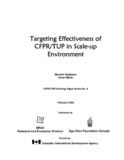| dc.description.abstract | Effective targeting is a hallmark of the BRAC’s CFPR/TUP program. Like many other targeted programs, CFPR/TUP combines a number of targeting methods. Launched in 2002, this program has scaled up in 2005. Despite this scaling up, success in targeting has been maintained. The principal objective of this paper is to investigate whether BRAC is reaching the poorest with its CFPR/TUP program. To measure the poverty status of the clients, the CGAP poverty assessment tool is used and it was observed that about three-quarters of the beneficiaries of this program belong to the poorest quartile. This is a commendable achievement when compared to other targeted programs. The success was achieved not only by adopting appropriate tools of targeting but also by implementing them rigorously. Community-based wealth ranking was found to be crucial in achieving a high level of aggregate accuracy. The paper concludes that there is a high level of convergence of community wealth ranking and objective measures of poverty. However, the little existing disparity may have been due to community ignorance of the status of some households and sympathy towards a few others. | en_US |

